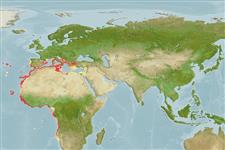Actinopterygii (ray-finned fishes) >
Perciformes (Perch-likes) >
Serranidae (Sea basses: groupers and fairy basslets) > Anthiinae
Etymology: Anthias: Greek, anthias, oy = a fish (Sparus aurata) (Ref. 45335).
Environment / Climate / Range
Ecology
Marine; reef-associated; depth range ? - 300 m (Ref. 2683), usually 30 - 50 m (Ref. 27115). Subtropical; 16°C - 22°C (Ref. 27115), preferred 19°C (Ref. 107945); 72°N - 36°N, 23°W - 42°E
Eastern Atlantic: Mediterranean and Portugal to Angola, including the Azores. Range reported to extend south to northern Namibia (Ref. 27121).
Size / Weight / Age
Maturity: Lm ? range ? - ? cm
Max length : 27.0 cm SL male/unsexed; (Ref. 3397); common length : 15.0 cm SL male/unsexed; (Ref. 3397)
Lives amongst rocks, gravel, coral (Ref. 2683) and in submarine caves on the continental shelf and upper slope. Nocturnal. Feeds on crustaceans and small fishes. Protogynous.
Life cycle and mating behavior
Maturity | Reproduction | Spawning | Eggs | Fecundity | Larvae
Protogyny is unconfirmed for this species (Ref. 103751).
Tortonese, E., 1986. Serranidae. p. 780-792. In P.J.P. Whitehead, M.-L. Bauchot, J.-C. Hureau, J. Nielsen and E. Tortonese (eds.) Fishes of the north-eastern Atlantic and the Mediterranean. UNESCO, Paris. vol. 2. (Ref. 5506)
IUCN Red List Status (Ref. 115185)
CITES (Ref. 94142)
Not Evaluated
Threat to humans
Harmless
Human uses
Fisheries: commercial; gamefish: yes; aquarium: commercial
More information
ReferencesAquacultureAquaculture profileStrainsGeneticsAllele frequenciesHeritabilityDiseasesProcessingMass conversion
Tools
Special reports
Download XML
Internet sources
Estimates of some properties based on models
Phylogenetic diversity index (Ref.
82805): PD
50 = 0.5039 [Uniqueness, from 0.5 = low to 2.0 = high].
Bayesian length-weight: a=0.01023 (0.00448 - 0.02337), b=2.93 (2.73 - 3.13), in cm Total Length, based on LWR estimates for this species & (Sub)family-body (Ref.
93245).
Trophic Level (Ref.
69278): 3.8 ±0.58 se; Based on food items.
Resilience (Ref.
69278): Medium, minimum population doubling time 1.4 - 4.4 years (Preliminary K or Fecundity.).
Vulnerability (Ref.
59153): Moderate vulnerability (38 of 100) .
